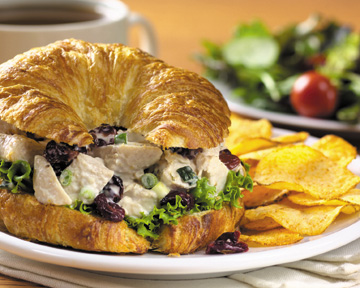Failures in food hygiene are presented commonly. I experienced this while picking up my lunch recently in Springfield, Missouri. This quaint bar and grill near Sequiota Park presented me with the decision to eat it or not.
The chicken salad sandwich was excellent but watching the preparation was not excellent. The chicken salad mix was covered but sat on the prep counter at room temperature. The owner, I assume, spooned the salad mix onto a croissant that he had just bare handedly cut and separated into two halves. He  patted the two halves back together when finished and he pushed the spewing excess back into the seams. He set the creation into a to-go box, piled a few potato chips on top (again bare handed), and got a pickle from somewhere (it wasn’t from a jar). He served it with a kind-of-a-smile that I hope does not cost me in the future.
patted the two halves back together when finished and he pushed the spewing excess back into the seams. He set the creation into a to-go box, piled a few potato chips on top (again bare handed), and got a pickle from somewhere (it wasn’t from a jar). He served it with a kind-of-a-smile that I hope does not cost me in the future.
Breaks in food hygiene protocol can cause significant discomfort to a large number of patrons. Bare hands and improperly-kept utensils can transfer foodborne-illness-causing bacteria to the prepared food or from potentially hazardous foods to ready-to-eat items. When a food preparer handles money, works the cash register, or touches the face or body while wearing gloves, the potential for contamination of ready-to-eat foods is also high.
A simple breech in food hygiene is not so simple to correct. The process of food safety is complicated and there is a constant vigilance required to prevent or mitigate foodborne illness.

 infestation during an inspection in October 2007. A conviction was recorded.
infestation during an inspection in October 2007. A conviction was recorded. They sure do.
They sure do.(8).jpg) the restaurant was cut off due to a water-main break. The restaurant was shut down by the region that month, but reopened with a clean bill of health in August that year.
the restaurant was cut off due to a water-main break. The restaurant was shut down by the region that month, but reopened with a clean bill of health in August that year..jpg) sitting out for too long — and filthy kitchens.
sitting out for too long — and filthy kitchens. clean with a sopping wet dish towel.
clean with a sopping wet dish towel..png) on doors be rolled out across Australia.
on doors be rolled out across Australia..png) breaches — yet Victoria has only three prosecutions on its website, compared to 1821 penalty notices in NSW.
breaches — yet Victoria has only three prosecutions on its website, compared to 1821 penalty notices in NSW.
.jpg) line with other developed countries, by shifting from an inspection-based system to a risk-based approach.
line with other developed countries, by shifting from an inspection-based system to a risk-based approach. them about high bacteria levels in shellfish.
them about high bacteria levels in shellfish. The P.E.I. Shellfish Association suggests putting yellow warning flags in the water when there’s a possible closure and a red one when the fishery is shut down.
The P.E.I. Shellfish Association suggests putting yellow warning flags in the water when there’s a possible closure and a red one when the fishery is shut down..jpg) appeal their conviction for serving food unfit for human consumption that resulted in a fine of $7,500 each.
appeal their conviction for serving food unfit for human consumption that resulted in a fine of $7,500 each.